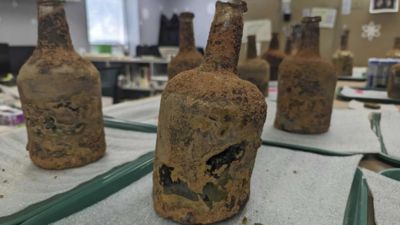
18th century artifacts found underneath George Washington's residence in Mount Vernon, Va., Monday, June 17, 2024. (AP)
George Washington
, the first US president, is often associated with the famous story of cutting down a cherry tree, which is not historically accurate. However, a recent
archaeological discovery
at his
Mount Vernon
estate revealed that Washington had a fondness for
cherries
and other fruits. During a restoration project, dozens of
bottles
containing perfectly preserved cherries and berries were found in storage pits in the cellar of his mansion on the Potomac River.
The discovery of such well-preserved fruit from over 250 years ago is considered extremely rare and remarkable. Mount Vernon's principal archaeologist, Jason Boroughs, emphasized the significance of the find, stating, "Finding what is essentially fresh fruit, 250 years later, is pretty spectacular."
Mount Vernon is collaborating with the US department of agriculture to conduct DNA testing on the fruit and examine the cherry pits to determine if any can be used to grow new trees. Although the chances of successfully growing a tree from the waterlogged pits are slim, the bottles themselves provide valuable insights into
preservation techniques
and the dietary preferences of the Washingtons.
Historical records indicate that George and Martha Washington enjoyed cherries, particularly when mixed with brandy, as evidenced by Martha's recipe for a "cherry bounce" cocktail. However, the cherries found in the bottles were likely intended to be consumed as fresh fruit. The exceptional preservation quality of the fruit is attributed to the highly skilled work of the enslaved individuals who managed the plantation's kitchen and oversaw the bottling process.
The bottles were discovered during a $40 million revitalization project of the mansion, which is expected to be completed by the nation's 250th birthday in 2026. The archaeological work, which is inherently destructive, was necessary due to the structural repairs required for the mansion. The bottles predate 1775, as determined by the expansion of the mansion that led to the area being covered with a brick floor.
In total, 35 bottles were found in six distinct storage pits, with 29 bottles intact and six broken. The bottles contained a mix of cherries and other berries, believed to be currants and gooseberries. Archaeologists are excited about the wealth of information that can be gleaned from these bottles, providing valuable insights into the dietary habits and preservation techniques of the time.

 5 months ago
22
5 months ago
22








